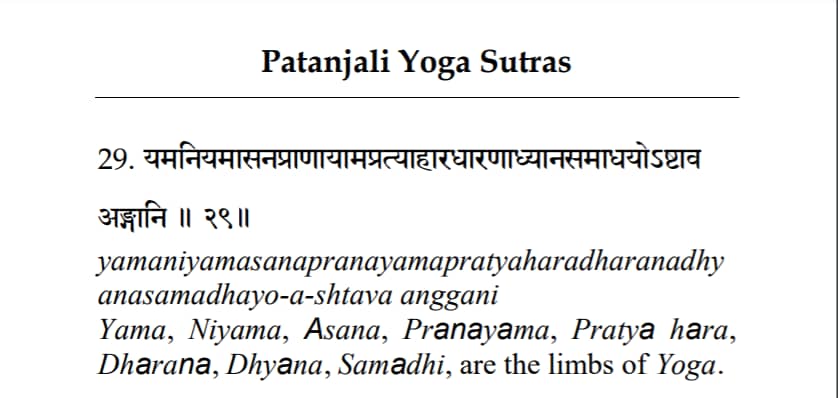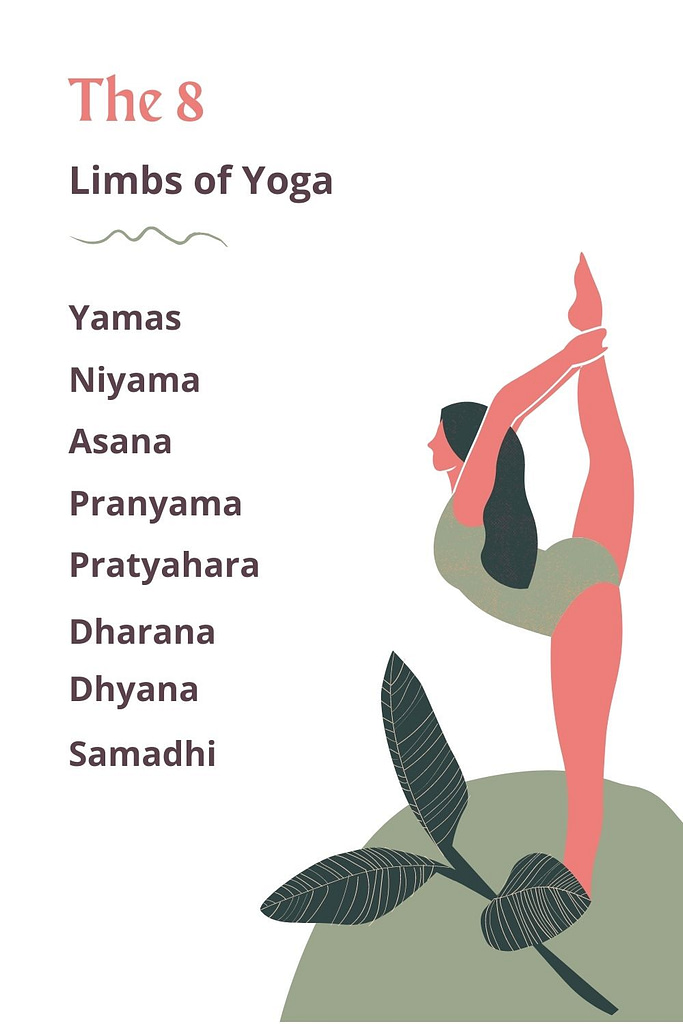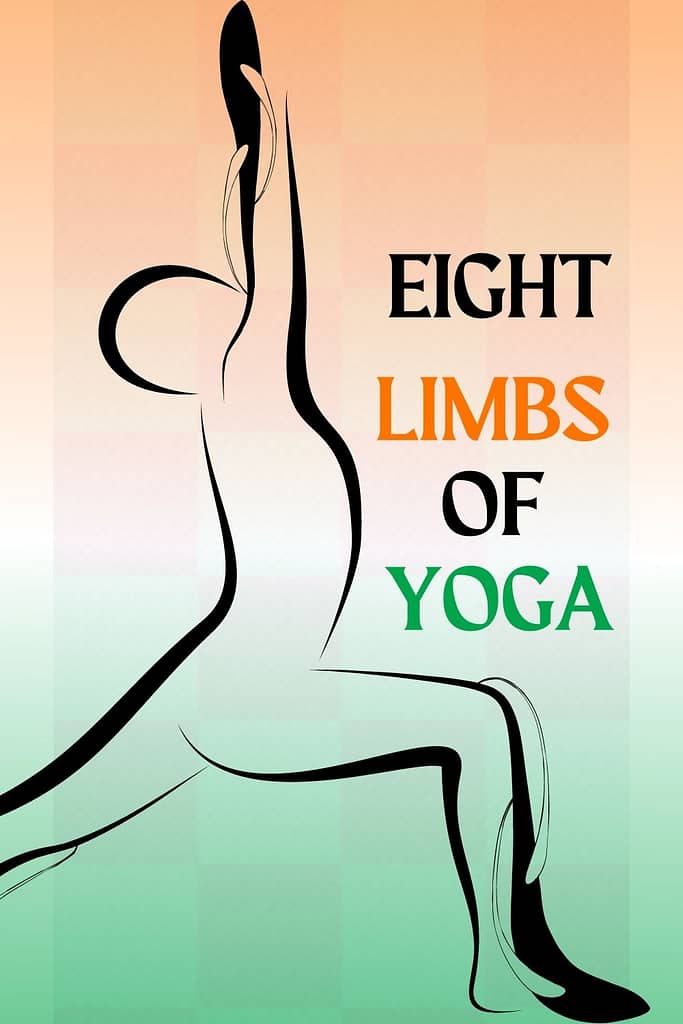Patanjali yoga sutras by rishi Patanjali describes 8 aids to achieving the state of Yoga. The yoga sutras contain 4 padas (chapters) which deal with Samadhi, Sadhana (ways to achieve yoga), Vibhuti (powers that the yogi comes across in his journey) and Kaivalya (absolution). The 8 limbs of yoga are described under the Sadhana pada. They are

मभणनमभासनप्रािामाभप्रत्याहायधायिाध्यानसभाधमोऽष्टाव अङ्गाणन ॥ २९॥
Patanjali Yoga Sutras
yamaniyamasanapranayamapratyaharadharanadhy anasamadhayo-a-shtava anggani
Yama, Niyama, Asana, Pranayama, Pratya hara, Dharana, Dhyana, Samadhi, are the limbs of Yoga.

1. Yama / Restraints
Yama are the behavioral and ethical standards that are to be practiced by a spiritual seeker. These define how one should conduct themselves in life as well as an attitude towards things and people other than ourselves. These are:
- Ahiṃsā (अहिंसा) – Non Violence. Not harming another living creature. Having kindness and compassion towards all beings.
- Satya (सत्य) – Truthfulness in everything you do.
- Asteya (अस्तेय) – Non stealing or possessing something that does not belong to you.
- Brahmacharya (ब्रह्मचर्य) – Celibacy or sexual restraint. It also means continence towards sexual urges.
- Aparigraha (अपरिग्रहः) – Taking only whatever is necessary. It also means to keep yourself away from excessive greed of possessing. Living life in a simple way.
2. Niyama / Observances (self purification by discipline)
Niyamas are described as the rules to follow for external purification of the body. An unclean body cannot achieve a state of Yoga or high spiritual state. The niyamas are:
- Śauca (शौच) : To maintain purity and cleanliness of the mind and body. This is done by practicing yoga and meditation. This also includes keeping the body clean.
- Santoṣa (सन्तोष): Santosa in Sanskrit means to keep content. It means having a sense of satisfaction and content in all aspects of life by accepting the circumstances as they are.
- Tapas (तपस) : Tapas means to keep a strict self discipline and austerity. It includes watching every movement of your mind and body, watching what we eat, think and how we breath.
- Svādhyāya (स्वाध्याय): It means self study of sacred texts, scriptures mantras and prayers. Study of scriptures helps with self reflection and self examination.
- Īśvara Praṇidhāna (ईश्वरप्रणिधान): It means devotion to a higher purpose or being than ourselves. Devoting oneself to a god like entity or guru helps diminish the ego and takes one toward achieving yoga.
3. Asana / posture (आसन)
Asana means to maintain a posture. Rishi patanjali describes an Asana as a posture in which a pactitioner sits. It is described as a firm as well as relaxed position. To attain a state of higher conciousness, the practitioner is required to sit in one particular posture for long hours. This is achieved through rigorous practice of 108 yogasanas or yogic postures described by Patanjali.
The practice of yogasanas keep the body healthy and the mind concentrated, aware and relaxed. The yogi becomes free of body consciousness.
4. Pranayama / Rhythmic Control Of The Breath (प्राणायाम)
The next two limbs of yoga are pranayama and pratyahara. They are known as the inner quests or antaranga sadhana. The practice of these two stages makes the yogi free the senses from objects of desire and makes him more detached from worldly desires.
Pranayama essentially means to control the breath. Prana means the life force and yama means to restraint or control. Breath is the life source which is altered in specific patterns to help tame the mind. The mind becomes calmer and focused. The practitioner becomes increasingly aware of the flow of prana in and out of the body.
5. Pratyahara (प्रत्याहार)
Pratyahara means the withdrawal of the senses. It is an effort from the practitioner to detach himself from the distractions and external stimuli of the outside world. Practicing detachment from the senses directs the attention internally and makes the yogi observe himself.
6. Dharana / concentration (धारणा)
Dharana means a one point focus. The practice of this step develops a highly concentrated mind and a higher state of meditation and peace can be achieved.
7. Dhyana / meditation (ध्यान)
Dhyana is the next step to Dharana. In dharana, the sadhaka experiences moments of high concentration while in Dhyana, due to great focus, a sense of constant awareness is experienced. The mind becomes quiet, aware and meditative with little or no thoughts.
8. Samadhi / Pure Contemplation/ Enlightenment (समाधि)
When Dhyana is practiced, a state of calm super consciousness is achieved. The mind becomes completely still while being completely aware. It is an exalted state of consciousness where the sadhaka becomes one with Paramatma or the Universal Spirit. It is also popularly known as a state of Enlightenment.

